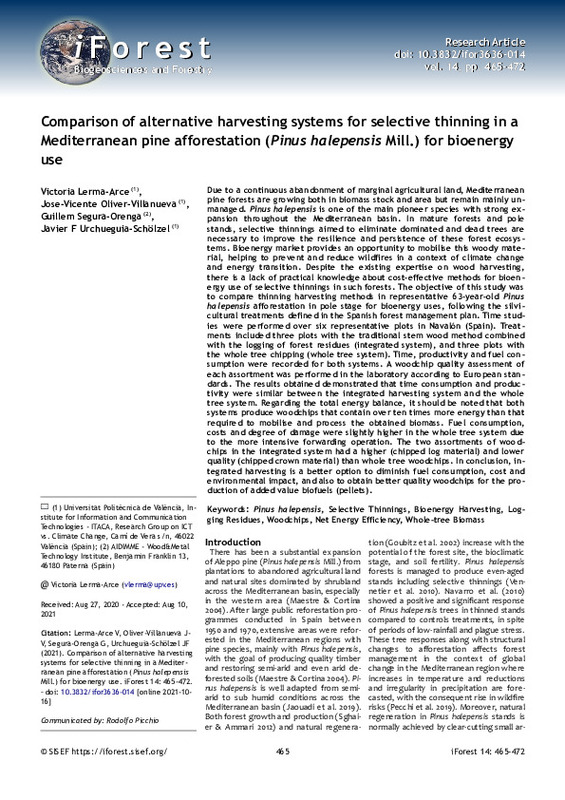JavaScript is disabled for your browser. Some features of this site may not work without it.
Buscar en RiuNet
Listar
Mi cuenta
Estadísticas
Ayuda RiuNet
Admin. UPV
Desde el lunes 3 y hasta el jueves 20 de marzo, RiuNet funcionará en modo de solo lectura a causa de su actualización a una nueva versión.
Comparison of alternative harvesting systems for selective thinning in a Mediterranean pine afforestation (Pinus halepensis Mill.) for bioenergy use
Mostrar el registro completo del ítem
Lerma Arce, V.; Oliver Villanueva, JV.; Segura-Orenga, G.; Urchueguía Schölzel, JF. (2021). Comparison of alternative harvesting systems for selective thinning in a Mediterranean pine afforestation (Pinus halepensis Mill.) for bioenergy use. iForest - Biogeosciences and Forestry. 14:465-472. https://doi.org/10.3832/ifor3636-014
Por favor, use este identificador para citar o enlazar este ítem: http://hdl.handle.net/10251/189821
Ficheros en el ítem
Metadatos del ítem
| Título: | Comparison of alternative harvesting systems for selective thinning in a Mediterranean pine afforestation (Pinus halepensis Mill.) for bioenergy use | |
| Autor: | Segura-Orenga, Guillem | |
| Entidad UPV: |
|
|
| Fecha difusión: |
|
|
| Resumen: |
[EN] Due to a continuous abandonment of marginal agricultural land, Mediterranean pine forests are growing both in biomass stock and area but remain mainly unmanaged. Pinus halepensis is one of the main pioneer species ...[+]
|
|
| Palabras clave: |
|
|
| Derechos de uso: | Reconocimiento - No comercial (by-nc) | |
| Fuente: |
|
|
| DOI: |
|
|
| Editorial: |
|
|
| Versión del editor: | https://doi.org/10.3832/ifor3636-014 | |
| Código del Proyecto: |
|
|
| Agradecimientos: |
VLA and JVOV conceived the study and draft the manuscript; VLA carried out the field measurements; VLA and GSO carried out the biomass tests in the laboratory; VLA, JVOV and JFUS performed the statistical analysis. This ...[+]
|
|
| Tipo: |
|









